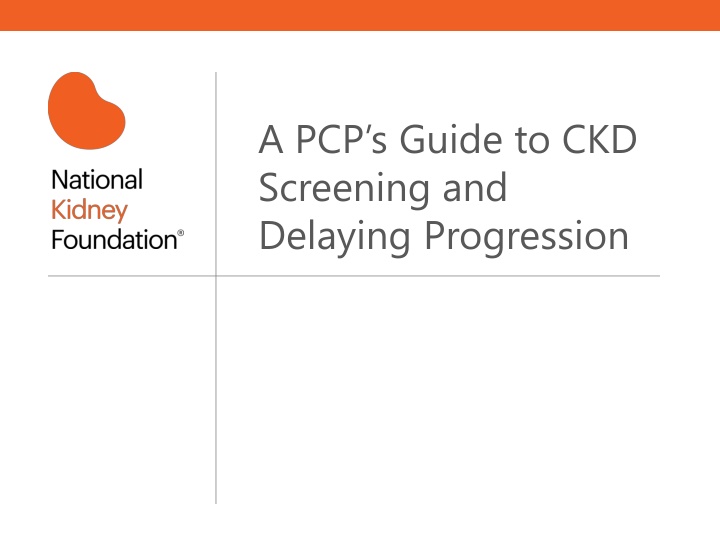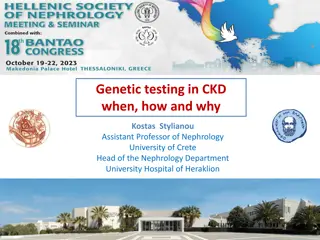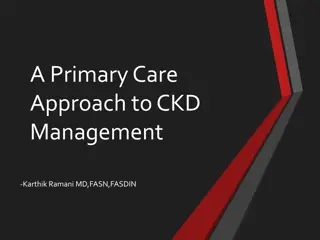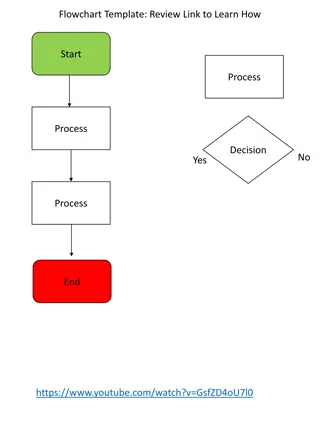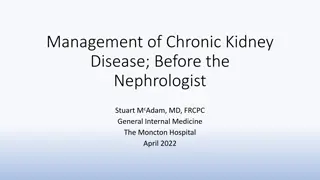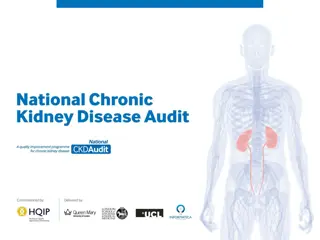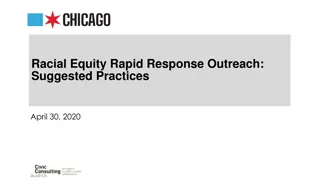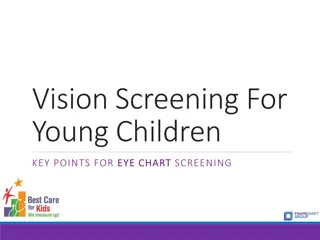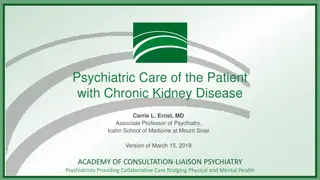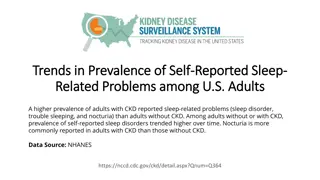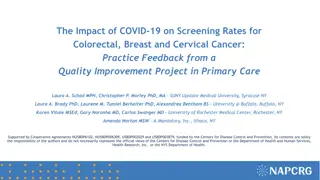Guide to CKD Screening and Delaying Progression
This comprehensive guide covers essential aspects of Chronic Kidney Disease (CKD) management, including screening tools, classification based on GFR and albuminuria, evidence-based strategies for delaying progression, case scenarios, patient care steps, and definitions. Learn how to diagnose, monitor, and treat CKD effectively to improve patient outcomes.
Download Presentation

Please find below an Image/Link to download the presentation.
The content on the website is provided AS IS for your information and personal use only. It may not be sold, licensed, or shared on other websites without obtaining consent from the author.If you encounter any issues during the download, it is possible that the publisher has removed the file from their server.
You are allowed to download the files provided on this website for personal or commercial use, subject to the condition that they are used lawfully. All files are the property of their respective owners.
The content on the website is provided AS IS for your information and personal use only. It may not be sold, licensed, or shared on other websites without obtaining consent from the author.
E N D
Presentation Transcript
A PCPs Guide to CKD Screening and Delaying Progression
Learning Objectives Utilize appropriate screening tools, such as GFR and ACR, in order to diagnose and monitor CKD patients. Classify CKD, based on GFR and albuminuria categories, in order to guide appropriate treatment. Implement evidence-based management strategies to delay CKD progression in patients and improve outcomes.
Case Question 1 A 55 year-old Caucasian-American man, with a history of type 2 diabetes (15 years), hypertension (3 years) dyslipidemia (5 years) and cardiovascular disease (myocardial infarction 3 years ago). He was recently diagnosed with CKD. His most recent labs reveal an eGFR of 45 ml/min/1.73m2 and an ACR of 38 mg/g. Which of the following should be avoided? A. ACE and ARB in combination B. Daily low-dose aspirin C. NSAIDs D. Statins E. A and C
Case Question 2 All of the following adult patients should be referred for nephrology consultation, EXCEPT? A. Initial visit: eGFR 26 & 3 months later: eGFR 28 (mL/min/1.73m2) B. Initial visit: eGFR 55, & 3 months later: eGFR 43 confirmed with repeat eGFR 45 (mL/min/1.73m2) C. Initial visit: ACR 450 & 3 months later: ACR 355 (mg/g) on both dates the eGFR > 60 mL/min/1.73m2 D. Initial visit: eGFR > 60 & 3 months later: eGFR > 60 (mL/min/1.73m2) with personal history of Autosomal Dominant Polycystic Kidney Disease. E. Initial visit: eGFR 42 & 3 months later: eGFR 44 (mL/min/1.73m2) on both dates the ACR < 30 mg/g.
Steps to CKD Patient Care 1. Does the patient have CKD? 2. Assess GFR, albuminuria 3. Determine etiology 4. Assess for evidence of progression 5. Assess for associated complications 6. Patient education 7. Assess life expectancy and patient wishes for dialysis/transplantation
Definition of Chronic Kidney Disease CKD is defined as abnormalities of kidney structure or function, present for >3 months, with implications for health. Kidney Disease: Improving Global Outcomes (KDIGO) CKD Work Group. Kidney Int Suppls. 2013;3:1-150.
Assign Albuminuria Category Albuminuria Categories in CKD Category A1 A2 A3 ACR (mg/g) < 30 30-300 > 300 Terms Normal to mildly increased Moderately increased* Severely increased** *Relative to young adult level. ACR 30-300 mg/g for > 3 months indicates CKD. **Including nephrotic syndrome (albumin excretion ACR > 2220 mg/g). Kidney Disease: Improving Global Outcomes (KDIGO) CKD Work Group. Kidney Int Suppls. 2013;3:1-150.
Assign GFR Category GFR Categories in CKD Clinical Presentations Category GFR Terms G1 90 Normal or high Markers of kidney damage (nephrotic syndrome, nephritic syndrome, tubular syndromes, urinary tract symptoms, asymptomatic urinalysis abnormalities, asymptomatic radiologic abnormalities, hypertension due to kidney disease) Mild to severe complications: o Anemia o Mineral and bone disorder Elevated parathyroid hormone o Cardiovascular disease Hypertension Lipid abnormalities o Low serum albumin Includes all of the above Uremia G2 60-89 Mildly decreased* G3a 45-59 Mildly to moderately decreased G3b 30-44 Moderately to severely decreased G4 15-29 Severely decreased G5 < 15 Kidney failure GFR = mL/min/1.73 m2 *Relative to young adult level In the absence of evidence of kidney damage, neither GFR category G1 nor G2 fulfill the criteria for CKD. Refer to a nephrologist and prepare for kidney replacement therapy when GFR <30 mL/min/1.73m2. Kidney Disease: Improving Global Outcomes (KDIGO) CKD Work Group. Kidney Int Suppls. 2013;3:1-150.
Classification of CKD Based on GFR and Albuminuria Categories: Heat Map Albuminuria categories Description and range CKD is classified based on: Cause (C) GFR (G) Albuminuria (A) A1 A2 A3 Normal to mildly increased Moderately increased Severely increased 30-299 mg/g 3-29 mg/mmol Monitor 1 Monitor 1 Monitor 2 300 mg/g 30 mg/mmol Refer* 2 Refer* 2 Refer 3 <30 mg/g <3 mg/mmol Normal or high 1 if CKD G1 90 GFR catagproes (ml/min/1.73 m2 Mildly decreased Mildly to moderately decreased Moderately to severely decreased Severely decreased 1 if CKD G2 60-90 Description and range Monitor 1 G3a 45-59 Monitor 2 Refer* 3 Refer 4+ Monitor 3 Refer* 3 Refer 4+ Refer 3 Refer 4+ Refer 4+ G3b 30-44 G3 15-29 G5 Kidney failure <15 Colors: Represents the risk for progression, morbidity and mortality by color from best to worst. Green: low risk (if no other markers of kidney disease, no CKD); Yellow: moderately increased risk; Orange: high risk; Red, very high risk. Numbers: Represent a recommendation for the number of times per year the patient should be monitored. Refer: Indicates that nephrology referral and services are recommended. *Referring clinicians may wish to discuss with their nephrology service depending on local arrangements regarding monitoring or referral. Adapted from Kidney Disease: Improving Global Outcomes (KDIGO) CKD Work Group. Kidney Int Suppls. 2013;3:1-150.
Screening Tools: eGFR Considered the best overall index of kidney function. Normal GFR varies according to age, sex, and body size, and declines with age. The NKF recommends using the CKD-EPI Creatinine Equation (2009) to estimate GFR. Other useful calculators related to kidney disease include MDRD and Cockroft Gault. GFR calculators are available online at www.kidney.org/GFR. Summary of the MDRD Study and CKD-EPI Estimating Equations: https://www.kidney.org/sites/default/files/docs/mdrd-study-and-ckd-epi-gfr-estimating-equations-summary-ta.pdf
eGFR, SCr Comparison Weight in lbs Height in Ft/in SCr mg/dl eGFR ml/ min per CKD-EPI eGFR Adj for BMI Age Sex Race 25 285 6 180 5 4 155 5 8 98 5 1 M AA 1.6 68 97 49 F Hispanic 1.6 38 41 67 M Asian 1.6 44 46 92 F Caucasian 1.6 28 22
Average Measured GFR by Age in People Without CKD Coresh J, et al. Am J Kidney Dis. 2003;41(1):1-12.
Use These Equations Cautiously, if at all in . Patients who have/are: o Poor nutrition/loss of muscle mass o Amputation o Chronic illness o Not African American or Caucasian o Changing serum creatinine o Obese o Very elderly, young
Clinical Evaluation of Patients with CKD Blood pressure HbA1c Serum creatinine o Use a GFR estimating equation or clearance measurement; don t rely on serum creatinine concentration alone o Be attentive to changes in creatinine over time--even in normal range Urinalysis o Urine sediment o Spot urine for protein/creatinine or albumin/creatinine ratio Albuminuria/Proteinuria Electrolytes, blood glucose, CBC
Clinical Evaluation of Patients with CKD Depending on stage: albumin, phosphate, calcium, iPTH Renal imaging Depending on age and H&P o Light chain assay, serum or urine protein electrophoresis (SPEP, UPEP) o HIV, HCV, HBV tests o Complements, other serologies limited role unless specific reason
Clinical Evaluation of Patients with CKD Standard urine dipsticks detect total protein >30 mg/dL - not sensitive enough for microalbuminuria screening Untimed, random spot urine for albumin/creatinine or protein/creatinine ratio (first morning void preferred)
Definitions: Albuminuria and Proteinuria Normal Albuminuria o Albumin:creatinine ratio < 30 mg/g creatinine Moderately Increased Albuminuria o Albumin:creatinine ratio 30-300 mg/g creatinine o 24-hour urine albumin 30-300 mg/d Severely Increased Albuminuria o Albumin:creatinine ratio > 300 mg albumin/g creatinine o 24-hour urine albumin > 300 mg/d Proteinuria o (+) urine dipstick at > 30 mg/dl o > 200 mg protein/g creatinine o 24-hour urine protein > 300 mg/d
CKD- Progression of Kidney Failure Variable depending on several factors including (1) type of disease and (2) how well it is treated GFR 100 90 80 Stage 2 70 60 50 Stage 3 40 30 Stage 4 20 10 Stage 5 (Dialysis) Years 0 1 2 3 4 5 6 7
Blood Pressure and CKD Progression Control of BP more important than exactly which agents are used o Avoidance of side-effects is important With proteinuria: diuretic + ACEi or ARB No proteinuria: no clear drug preference o ACEi or ARB ok to use Fujisaki K, et al. Impact of combined losartan/hydrochlorothiazide on proteinuria in patients with CKD and hypertension. Hypertens Res. 2014;37:993-998.
Slowing CKD Progression: ACEi/ARB Check labs after initiation o If less than 25% SCr increase, continue and monitor o If more than 25% SCr increase, stop ACEi and evaluate for RAS Continue until contraindication arises, no absolute eGFR cutoff Better proteinuria suppression with low Na diet and diuretics Avoid volume depletion
Goals for Renoprotection Target blood pressure in non-dialysis CKD:1 o ACR <30 mg/g: 140/90 mm Hg o ACR 30-300 mg/g: 130/80 mm Hg* o ACR >300 mg/g: 130/80 mm Hg o Individualize targets and agents according to age, coexistent CVD, and other comorbidities Avoid ACEi and ARB in combination3,4 o Risk of adverse events (impaired kidney function, hyperkalemia) *Reasonable to select a goal of 140/90 mm Hg, especially for moderate albuminuria (ACR 30-300 mg/g.)2 1) Kidney Disease: Improving Global Outcomes (KDIGO) Blood Pressure Work Group. Kidney Int Suppl. (2012);2:341-342. 2) KDOQI Commentary on KDIGO Blood Pressure Guidelines. Am J Kidney Dis. 2013;62:201-213. 3) Kunz R, et al. Ann Intern Med. 2008;148:30-48. 4) Mann J, et al. ONTARGET study. Lancet. 2008;372:547-553.
Lower BP Slows Decline in GFR MAP (mmHg) 95 0 98 101 104 107 110 113 116 119 GFR (mL/min/year) -2 -4 -6 Untreated HTN -8 -10 -12 130/85 140/90 -14 But newer studies suggest there may be other dangers down here Bakris GL, et al. Am J Kidney Dis. 2000
ARBs and Progression of Diabetic Nephropathy Most placebo-controlled studies in type 2 DM have been in patients with either microalbuminuria or established nephropathy treated with ARB ARB and ACEi appear to be equivalent for microalbuminuria and proteinuria reduction Parving HH, et al. N Engl J Med. 2001
Managing Hyperglycemia Hyperglycemia is a fundamental cause of vascular complications, including CKD Poor glycemic control has been associated with albuminuria in type 2 diabetes. Risk of hypoglycemia increases as kidney function becomes impaired. Declining kidney function may necessitate changes to diabetes medications and renally-cleared drugs. Target HbA1c ~7.0% o Can be extended above 7.0% with comorbidities or limited life expectancy, and risk of hypoglycemia. NKF KDOQI. Diabetes and CKD: 2012 Update. Am J Kidney Dis. 2012 60:850-856.
Other Goals of CKD Management Limit sodium intake to < 90 mmol (2 gm; 5 gm salt) per day CVD management: lipids, ASA (secondary prevention), etc
Lipid Disorders in CKD Use statin alone or statin + ezetimibe in adults > 50 yrs with CKD 3-5(ND) Use statin alone in adults > 50 yrs with CKD 1-2 In adults < 50 yrs use statin alone if history of known CAD, MI, DM, stroke Treat according to a fire and forget rather than treat to target strategy o Treat CKD patients (Non dialysis) with statins or Statin/exterminate combinations without the need for follow up blood tests. Kidney Disease: Improving Global Outcomes (KDIGO) Lipid Work Group. Kidney Int Suppl. 2013;3:259-305. http://kdigo.org/home/2013/11/04/kdigo-announces-publication- of-guideline-on-lipid-management/
Lipid Disorders in CKD A 32% reduction in LDL 17% reduction in primary outcome (nonfatal MI, coronary death, nonhemorrhagic stroke, arterial revascularization) No reduction in CKD progression, overall or CAD mortality, other individual CAD end-points Baigent C, et al. Study of Heart and Renal Protection (SHARP). Lancet. 2011;11:60739-60743.
10-Year Coronary Risk Based on Age and Other Patient Characteristics Future 10-year coronary risk based on various patient characteristics. Data are unadjusted rates from 1,268,029 participants in the Alberta Kidney Disease cohort.1,2 1) Kidney Disease: Improving Global Outcomes (KDIGO) Lipid Work Group. Kidney Int Suppl. 2013;3:259-305. 2) Hemmelgarn BR, et al. Overview of the alberta kidney disease network. BMC Nephrol. 2009:30:10. CABG, coronary artery bypass grafting; CHD, coronary heart disease; CKD, chronic kidney disease; CVA, cerebrovascular accident; DM, diabetes mellitus; MI, myocardial infarction; PTCA, percutaneous transluminal coronary angioplasty; TIA, transient ischemic attack.
Overview of Managing CKD Complications
Complications of Kidney Failure Start in Stage 3 and Progress Fluid overload Water overload Acid Base Imbalance Acidic Blood Electrolyte Abnormalities Malnutrition Kidney Failure Bone Disease Brittle bones And fractures Hypertension Cardiac Disease Vascular Disease Anemia/blood loss Decrease production Of red blood cells
Anemia in CKD Initiate iron therapy if TSAT 30% and ferritin 500 ng/mL (IV iron for dialysis, Oral for non-dialysis CKD) Individualize ESA therapy Start ESA if Hb <10 g/dl, and maintain Hb <11.5 g/dl. Ensure adequate Fe stores. o Appropriate iron supplementation is needed for ESA to be effective ESA usually not required for nephrogenic anemia until late CKD 4/CKD 5 Diagnostic workup of anemia is particularly important if severity of anemia is disproportionate to CKD staging Important to avoid transfusion in transplant candidates o If transfused use leukocyte filter to reduce HLA sensitization
CKD-MBD Testing PTH Calcium, Phosphorus CKD Stage 25(OH)D Once then based on CKD progression Every 6-12 months Stage 3 Once, then based on level and treatments Every 6-12 months Stage 4 Every 3-6 months Stage 5 Every 1-3 months Every 3-6 months Use CKD progression, presence or absence of abnormalities, treatment response and side effects to guide testing frequency.
CKD-MBD Treat with D3 as indicated to achieve normal serum levels 2000 IU po qd is cheaper and better absorbed than 50,000 IU monthly dose. Limit phosphorus in diet, with emphasis on decreasing packaged products - Refer to renal RD May need phosphate binders DEXA doesn t predict fracture risk in CKD 3-5
Metabolic Acidosis Often becomes apparent at GFR < 25-30 ml/min More severe with higher protein intake May contribute to bone disease, protein catabolism, and progression of CKD Correction of metabolic acidosis may slow CKD progression and improve patients functional status1,2 Adults with CKD (eGFR 15-30 ml/min/1.73m2) with bicarbonate 16-20 mmol/L; treated with sodium bicarbonate for 2 years to normalize serum bicarbonate concentration2 1) Mahajan, et al. Kidney Int. 2010;78:303-309. 2) de Brito-Ashurst I, et al. J Am Soc Nephrol. 2009;20:2075-2084.
Metabolic Acidosis Maintain serum bicarbonate > 22 mmol/L o Start with 0.5-1 mEq/kg per day o Sodium bicarbonate tablets 325mg, 625 mg tablets; 1 g = 12 mEq o Sodium citrate solution 1 mEq/ml Avoid if on aluminum phosphate binders o Baking soda 54 mmol/level tsp
Hyperkalemia First try reduction of dietary potassium Stop NSAIDs, COX-2 inhibitors Stop potassium sparing diuretics o Aldactone Stop or reduce beta blockers Stop or reduce ACEi/ARBs Avoid salt substitutes that contain potassium
Acute Management of Hyperkalemia Treatment Expected serum K+ None Peak effect Duration Mechanism IV Calcium chloride Insulin + dextrose B2-adrenergic agonists Sodium bicarbonate Instant Transient Stabilize myocardium 0.5-1 mEq/L 30-60 mins 4-6 hrs Cellular shift 0.5-1 mEq/L 30 mins 2 hrs Cellular shift Variable depending on acidosis 4h Cellular shift Loop/ thiazide diuretics Hours renal K+ excretion Kamel KS, Wei C. Nephrol Dial Transplant. 18:2215-18, 2003.
Chronic Management of Hyperkalemia Loop or thiazide diuretics Laxatives o As effective as cation exchange resins in sorbitol o Those that induce secretory diarrhea may be more effective (e.g. bisacodyl) o Diphenolic laxatives may stimulate colonic K+ secretion Cation exchange resins o Sodium polystyrene sulfonate o Mechanism Theoretical: Bound Na+ exchanged for K+ in colonic/ rectal lumen Likely: Accompanying sorbitol induces diarrhea o Usually requires multiple doses o Risk of bowel necrosis or perforation
Risk Factors for Infection in People with CKD Advanced age High burden of coexisting illnesses (e.g., diabetes) Hypoalbuminuria Immunosuppressive therapy Nephrotic syndrome Uremia Anemia and malnutrition High prevalence of functional disabilities Kidney Disease: Improving Global Outcomes (KDIGO) CKD Work Group. Kidney Int Suppls. 2013;3:1-150.
Vaccination in CKD Annual influenza vaccine for all adults with CKD, unless contraindicated. Polyvalent pneumococcal vaccine when eGFR < 30 ml/min/1.73m2 and at high risk of pneumococcal infection (e.g., nephrotic syndrome, diabetes, receiving immunosuppression), unless contraindicated. Offer revaccination within 5 years. Hepatitis B immunization when GFR < 30 ml/min/1.73 m2. Confirm response with appropriate serological testing. Use of a live vaccine should consider the patient s immune status (e.g., immunosuppression). Kidney Disease: Improving Global Outcomes (KDIGO) CKD Work Group. Kidney Int Suppls. 2013;3:1-150.
Malnutrition and CKD Malnutrition or protein energy wasting (PEW) is common in CKD and is associated with poor patient outcomes. Malnutrition in CKD begins as early as stages 3 and 4. Risk increases with progression of the disease. Preventing PEW or malnutrition may require clinical interventions to assess nutritional status, individualize strategies for prevention and treatment, provide patient instruction, and promote patient adherence. A specialty-trained registered dietician can help address the nutritional aspects so that protein wasting can be diminished. NKF KDOQI. Am J Kidney Dis. 2000;35(suppl 2):S1-S3. NKF KDOQI. Am J Kidney Dis. 2007;49(suppl 2):S1-S179.
A Balanced Approach to Nutrition in CKD: Macronutrient Composition and Mineral Content* Adapted from DASH (dietary approaches to stop hypertension) diet. *Adjust so total calories from protein, fat, and carbohydrate are 100%. Emphasize such whole-food sources as fresh vegetables, whole grains, nuts, legumes, low-fat or nonfat dairy products, canola oil, olive oil, cold-water fish, and poultry. *(CKD Stages 1-4) NKF KDOQI. Am J Kidney Dis. 2007;49(suppl 2):S1-S179.
Education and Counseling Ethical, psychological, and social care (e.g., social bereavement, depression, anxiety) Dietary counseling and education on other lifestyle modifications (e.g., exercise, smoking cessation) Involve the patient, family and children if possible Offer literature in both traditional and interactive formats Use educational materials written in the patient s language Assess the need for low-level reading materials Use internet resources and smartphone apps as appropriate Use visual aids such as handouts, drawings, CDs, and DVDs Involve other health care professionals in educating patients/families Be consistent in the information provided
Mental Health Counseling Psychiatric illnesses like depression are associated with many chronic diseases. Depression is linked to early CKD, progressive CKD, kidney failure, hospitalization and increased mortality. 1-4 Patients with GFR <60 mL/min/1.73m2 should undergo regular assessment for impairment of functioning and well-being.5 1) Palmer S, et al. Am J Kidney Dis. 2013;62:493-505. 2) Hedayati S, et al. Am J Kidney Dis. 2009 Sep;54(3):424-32. 3) Kimmel P, et al. Kidney Int. 2000;57:2093-2098. 4) Tsai Y, et al. Am J Kidney Dis. 2012;60:54-61. 5) NKF KDOQI. Am J Kidney Dis. 2002;39(2 Suppl 1):S1-266.
CKD Care Among Special Populations
Considerations for CKD Management in Older Adults More than 36 million adults are now over the age of 65 and some 50% have two or more chronic diseases.1 Management requires an individualized approach with attention to unique considerations for older adults. Treatment of hypertension in older adults has been shown to reduce CV morbidity and mortality. However, older frail adults should be monitored for risk of hypotension.2,3 Less stringent glycemic goals can be appropriate for older adults with other comorbidities, or those at higher risk for hypoglycemia.4 Exercise can have multiple benefits. A weight control program should be individually tailored to preserve body cell mass and function, while losing fat mass.5,6 1. 2. 3. 4. 5. 6. U.S. Census Bureau. Population by age and gender 2008. www.census.gov. Katz P, Gilbert J. Geriatrics and Aging. 2008;11:509-514. Aronow W. Clin Geriatr Med. 2008; 11(8):457-463. NKF KDOQI. Am J Kidney Dis. 2012 60:850-856. Hornick T, Aron D. Clev Clin J Med. 2008;75:70-78. NHLBI. ww.nhlbi.nih.gov.
Incidence of ESRD Varies Widely by Race and Ethnicity Incident ESRD patients; rates adjusted for age & gender. USRDS
Additional Online Resources for CKD Learning National Kidney Foundation: www.kidney.org United States Renal Data Service: www.usrds.org CDC s CKD Surveillance Project: http://nccd.cdc.gov/ckd National Kidney Foundation: www.kidney.org United States Renal Data Service: www.usrds.org National Kidney Disease Education Program (NKDEP): http://nkdep.nih.gov
